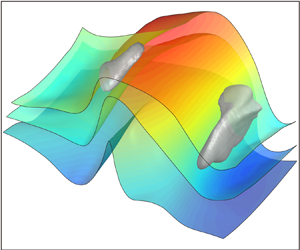Crossref Citations
This article has been cited by the following publications. This list is generated based on data provided by
Crossref.
Liu, De-min
Xu, Wei-lin
and
Zhao, Yong-zhi
2021.
Experimental study of the flow field of a high head model pump turbine based on PIV technique.
Journal of Hydrodynamics,
Vol. 33,
Issue. 5,
p.
1045.
Zhu, Yiding
Zhu, Wenkai
Gu, Dingwei
Lee, Cunbiao
and
Smith, C. R.
2021.
Characteristics of transition to turbulence over a Mach 6 flared cone.
Physics of Fluids,
Vol. 33,
Issue. 10,
Huang, Ganglei
Si, Wufei
and
Lee, Cunbiao
2021.
Early stage evolution of naturally developing Görtler streaks.
Physics of Fluids,
Vol. 33,
Issue. 6,
Zhu, Yiding
Zhu, Wenkai
Gu, Dingwei
Lee, Cunbiao
and
Smith, C. R.
2021.
Hypersonic transition over a heated wall.
Physics of Fluids,
Vol. 33,
Issue. 10,
Tang, Xin-ran
Dong, Xiang-rui
Cai, Xiao-shu
and
Zhou, Wu
2021.
Liutex identification on hairpin vortex structures in a channel based on msfle and moving-PIV.
Journal of Hydrodynamics,
Vol. 33,
Issue. 6,
p.
1119.
Jiang, X.Y.
Gu, D.W.
Lee, C.B.
Smith, C.R.
and
Linden, P.F.
2021.
A metamorphosis of three-dimensional wave structure in transitional and turbulent boundary layers.
Journal of Fluid Mechanics,
Vol. 914,
Issue. ,
Park, Jongyeol
Seo, Jeonghwa
and
Rhee, Shin Hyung
2021.
Towed Underwater LDV Measurement of the Interaction of a Wire-Type Stimulator and the Boundary Layer on a Flat Plate.
Journal of the Society of Naval Architects of Korea,
Vol. 58,
Issue. 4,
p.
243.
Huang, Ganglei
Si, Wufei
and
Lee, Cunbiao
2021.
Inner structures of Görtler streaks.
Physics of Fluids,
Vol. 33,
Issue. 3,
Han, Junhao
He, Lin
and
Wu, Zhengbang
2022.
Experimental investigation on evolution characteristics of high- and low-speed streaks in supersonic turbulent boundary layer.
AIP Advances,
Vol. 12,
Issue. 11,
Jiang, Xianyang
Lefauve, Adrien
Dalziel, Stuart B.
and
Linden, P.F.
2022.
The evolution of coherent vortical structures in increasingly turbulent stratified shear layers.
Journal of Fluid Mechanics,
Vol. 947,
Issue. ,
Wang, Yiqian
Huang, Yi
and
Fu, Song
2022.
On the tip sharpness of riblets for turbulent drag reduction.
Acta Mechanica Sinica,
Vol. 38,
Issue. 4,
Zheng, Wenqing
Kumar, Dhananjay
and
Li, Na
2022.
Numerical simulation of the airflow near the leading edge and trailing edge of a flat plate.
p.
71.
Zhu, Yiding
Zhu, Wenkai
Gu, Dingwei
Lee, Cunbiao
and
Smith, Charles R.
2022.
Transitional flow structures in heated hypersonic boundary layers.
Physics of Fluids,
Vol. 34,
Issue. 5,
Dave, Himanshu
and
Kasbaoui, M. Houssem
2023.
Mechanisms of drag reduction by semidilute inertial particles in turbulent channel flow.
Physical Review Fluids,
Vol. 8,
Issue. 8,
Wu, Haoyang
and
Song, Baofang
2023.
Scaling and mechanism of the propagation speed of the upstream turbulent front in pipe flow.
Journal of Fluid Mechanics,
Vol. 977,
Issue. ,
Xu, Dongdong
Ricco, Pierre
and
Marensi, Elena
2024.
Excitation and stability of nonlinear compressible Görtler vortices and streaks induced by free-stream vortical disturbances.
Journal of Fluid Mechanics,
Vol. 1000,
Issue. ,
Qiu, Hongtian
Shi, Mingtao
Zhu, Yiding
and
Lee, Cunbiao
2024.
Boundary layer transition of hypersonic flow over a delta wing.
Journal of Fluid Mechanics,
Vol. 980,
Issue. ,
Zhao, Guoqin
Ma, Tianju
Chen, Zongnan
Zhang, Zijian
Hao, Jiaao
and
Wen, Chih-Yung
2024.
Investigation of streamwise streak characteristics over a compression ramp at Mach 4.
Physics of Fluids,
Vol. 36,
Issue. 10,
Hu, Ning
Du, Bingyin
and
Lee, Cunbiao
2025.
Internal structures of turbulent spots.
Physics of Fluids,
Vol. 37,
Issue. 2,
Niu, Lin
Dou, Hua-Shu
Zhou, Changquan
and
Xu, Wenqian
2025.
Solitary wave structure of transitional flow in the wake of a sphere.
Physics of Fluids,
Vol. 37,
Issue. 1,

 $10 < y^+ < 100$) and assessed using time-line and material surface evolution, to reveal the flow structure and evolution of a streak, and the flow structure evolving from streak development. It is observed that three-dimensional wave behaviour of the detected LSSs appears to develop into associated near-wall vortex flow structures, in a process somewhat similar to transitional boundary layer behaviour. Fourth, the presence of Lagrangian coherent structures is assessed in proximity to the LSSs using a Lagrangian-averaged vorticity deviation process. It is observed that quasi-streamwise vortices, adjacent to the sides of the streak-associated three-dimensional wave, precipitate an interaction with the streak. Finally, a hypothesis based on the behaviour of soliton-like coherent structures is made which explains the process of LSS formation, bursting behaviour and the generation of hairpin vortices. Comparison with other models is also discussed.
$10 < y^+ < 100$) and assessed using time-line and material surface evolution, to reveal the flow structure and evolution of a streak, and the flow structure evolving from streak development. It is observed that three-dimensional wave behaviour of the detected LSSs appears to develop into associated near-wall vortex flow structures, in a process somewhat similar to transitional boundary layer behaviour. Fourth, the presence of Lagrangian coherent structures is assessed in proximity to the LSSs using a Lagrangian-averaged vorticity deviation process. It is observed that quasi-streamwise vortices, adjacent to the sides of the streak-associated three-dimensional wave, precipitate an interaction with the streak. Finally, a hypothesis based on the behaviour of soliton-like coherent structures is made which explains the process of LSS formation, bursting behaviour and the generation of hairpin vortices. Comparison with other models is also discussed.